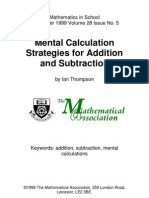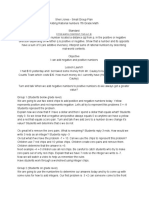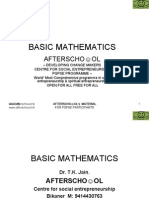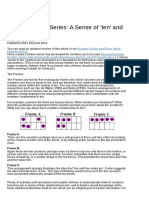0 ratings0% found this document useful (0 votes)
132 viewsNumber Sense Series Tips
Number Sense Series Tips
Uploaded by
MOHD ROZI ISMAILThis document discusses developing early number sense in children. It defines number sense as understanding numbers and their relationships. Key components include number meaning, relationships, magnitude, and operations. Good number sense is linked to skills like mental math and problem solving.
Number sense begins early as toddlers can recognize small quantities without counting. Teaching strategies should present numbers in various arrangements to prompt mental strategies beyond counting, like recognizing subgroups. Games can reinforce these ideas by having children copy and compare number arrangements.
Copyright:
© All Rights Reserved
Available Formats
Download as DOCX, PDF, TXT or read online from Scribd
Number Sense Series Tips
Number Sense Series Tips
Uploaded by
MOHD ROZI ISMAIL0 ratings0% found this document useful (0 votes)
132 views10 pagesThis document discusses developing early number sense in children. It defines number sense as understanding numbers and their relationships. Key components include number meaning, relationships, magnitude, and operations. Good number sense is linked to skills like mental math and problem solving.
Number sense begins early as toddlers can recognize small quantities without counting. Teaching strategies should present numbers in various arrangements to prompt mental strategies beyond counting, like recognizing subgroups. Games can reinforce these ideas by having children copy and compare number arrangements.
Copyright
© © All Rights Reserved
Available Formats
DOCX, PDF, TXT or read online from Scribd
Share this document
Did you find this document useful?
Is this content inappropriate?
This document discusses developing early number sense in children. It defines number sense as understanding numbers and their relationships. Key components include number meaning, relationships, magnitude, and operations. Good number sense is linked to skills like mental math and problem solving.
Number sense begins early as toddlers can recognize small quantities without counting. Teaching strategies should present numbers in various arrangements to prompt mental strategies beyond counting, like recognizing subgroups. Games can reinforce these ideas by having children copy and compare number arrangements.
Copyright:
© All Rights Reserved
Available Formats
Download as DOCX, PDF, TXT or read online from Scribd
Download as docx, pdf, or txt
0 ratings0% found this document useful (0 votes)
132 views10 pagesNumber Sense Series Tips
Number Sense Series Tips
Uploaded by
MOHD ROZI ISMAILThis document discusses developing early number sense in children. It defines number sense as understanding numbers and their relationships. Key components include number meaning, relationships, magnitude, and operations. Good number sense is linked to skills like mental math and problem solving.
Number sense begins early as toddlers can recognize small quantities without counting. Teaching strategies should present numbers in various arrangements to prompt mental strategies beyond counting, like recognizing subgroups. Games can reinforce these ideas by having children copy and compare number arrangements.
Copyright:
© All Rights Reserved
Available Formats
Download as DOCX, PDF, TXT or read online from Scribd
Download as docx, pdf, or txt
You are on page 1of 10
Number Sense Series: Developing
Early Number Sense
Stage: 1
Article by Jenni Way
You can read an updated version of this article in our Number Sense and
Place Value Feature.
What is number sense?
The term "number sense" is a relatively new one in mathematics education.
It is difficult to define precisely, but broadly speaking, it refers to "a well
organised conceptual framework of number information that enables a
person to understand numbers and number relationships and to solve
mathematical problems that are not bound by traditional algorithms" (Bobis,
1996). The National Council of Teachers (USA, 1989) identified five
components that characterise number sense: number meaning, number
relationships, number magnitude, operations involving numbers and
referents for numbers and quantities. These skills are considered important
because they contribute to general intuitions about numbers and lay the
foundation for more advanced skills.
Researchers have linked good number sense with skills observed in students
proficient in the following mathematical activities:
mental calculation (Hope & Sherrill, 1987;
Trafton, 1992);
computational estimation (for example;
Bobis, 1991; Case & Sowder, 1990);
judging the relative magnitude of numbers
(Sowder, 1988);
recognising part-whole relationships and
place value concepts (Fischer, 1990; Ross,
1989) and;
problem solving (Cobb et.al., 1991).
How does number sense begin?
An intuitive sense of number begins at a very early age. Children as young
as two years of age can confidently identify one, two or three objects before
they can actually count with understanding (Gelman & Gellistel, 1978).
Piaget called this ability to instantaneously recognise the number of objects
in a small group 'subitising'. As mental powers develop, usually by about the
age of four, groups of four can be recognised without counting. It is thought
that the maximum number for subitising, even for most adults, is five. This
skill appears to be based on the mind's ability to form stable mental images
of patterns and associate them with a number. Therefore, it may be possible
to recognise more than five objects if they are arranged in a particular way
or practice and memorisation takes place. A simple example of this is six
dots arranged in two rows of three, as on dice or playing cards. Because this
image is familiar, six can be instantly recognised when presented this way.
Usually, when presented with more than five objects, other mental
strategies must be utilised. For example, we might see a group of six objects
as two groups of three. Each group of three is instantly recognised, then
very quickly (virtually unconsciously) combined to make six. In this strategy
no actual counting of objects is involved, but rather a part-part-whole
relationship and rapid mental addition is used. That is, there is an
understanding that a number (in this case six) can be composed of smaller
parts, together with the knowledge that 'three plus three makes six'. This
type of mathematical thinking has already begun by the time children begin
school and should be nurtured because it lays the foundation for
understanding operations and in developing valuable mental calculation
strategies.
What teaching strategies promote early number sense?
Learning to count with understanding is a crucial number skill, but other
skills, such as perceiving subgroups, need to develop alongside counting to
provide a firm foundation for number sense. By simply presenting objects
(such as stamps on a flashcard) in various arrangements, different mental
strategies can be prompted. For example, showing six stamps in a cluster of
four and a pair prompts the combination of 'four and two makes six'. If the
four is not subitised, it may be seen as 'two and two and two makes six'.
This arrangement is obviously a little more complex than two groups of
three. So different arrangements will prompt different strategies, and these
strategies will vary from person to person.
If mental strategies such as these are to be encouraged (and just counting
discouraged) then an element of speed is necessary. Seeing the objects for
only a few seconds challenges the mind to find strategies other than
counting. It is also important to have children reflect on and share their
strategies (Presmeg, 1986; Mason, 1992). This is helpful in three ways:
verbalising a strategy brings the strategy to
a conscious level and allows the person to
learn about their own thinking;
it provides other children with the
opportunity to pick up new strategies;
the teacher can assess the type of thinking
being used and adjust the type of
arrangement, level of difficulty or speed of
presentation accordingly.
To begin with, early number activities are best done with moveable objects
such as counters, blocks and small toys. Most children will need the concrete
experience of physically manipulating groups of objects into sub-groups and
combining small groups to make a larger group. After these essential
experiences more static materials such as 'dot cards' become very useful.
Dot cards are simply cards with dot stickers of a single colour stuck on one
side. (However, any markings can be used. Self-inking stamps are fast when
making a lot of cards). The important factors in the design of the cards are
the number of dots and the arrangement of these dots. The various
combinations of these factors determine the mathematical structure of each
card, and hence the types of number relations and mental strategies
prompted by them.
Consider each of the following arrangements of dots before reading further.
What mental strategies are likely to be prompted by each card? What order
would you place them in according to level of difficulty?
Card A is the classic symmetrical dice and playing card arrangement of five
and so is often instantly recognised without engaging other mental
strategies. It is perhaps the easiest arrangement of five to deal with.
Card B presents clear sub-groups of two and three, each of which can be
instantly recognised. With practice, the number fact of 'two and three makes
five' can be recalled almost instantly.
Card C: A linear arrangement is the one most likely to prompt counting.
However, many people will mentally separate the dots into groups of two
and three, as in the previous card. Other strategies such as seeing two then
counting '3, 4, 5' might also be used.
Card D could be called a random arrangement, though in reality it has been
quite deliberately organised to prompt the mental activity of sub-grouping.
There are a variety of ways to form the sub-groups, with no prompt in any
particular direction, so this card could be considered to be the most difficult
one in the set.
Card E shows another sub-group arrangement that encourages the use (or
discovery) of the 'four and one makes five' number relation.
Obviously, using fewer than five dots would develop the most basic number
sense skills, and using more than five dots would provide opportunities for
more advanced strategies. However, it is probably not useful to use more
than ten dots. (See the follow-on article focusing on developing a 'sense of
ten' and 'place value readiness'). Cards such as these can be shown briefly
to children, then the children asked how many dots they saw. The children
should be asked to explain how they perceived the arrangement, and hence
what strategies they employed.
What games can assist development of early number sense?
Games can be very useful for reinforcing and developing ideas and
procedures previously introduced to children. Although a suggested age
group is given for each of the following games, it is the children's level of
experience that should determine the suitability of the game. Several
demonstration games should be played, until the children become
comfortable with the rules and procedures of the games.
Deal and Copy (4-5 years) 3-4 players
Materials: 15 dot cards with a variety of dot patterns representing the
numbers from one to five and a plentiful supply of counters or buttons.
Rules: One child deals out one card face up to each other player. Each child
then uses the counters to replicate the arrangement of dots on his/her card
and says the number aloud. The dealer checks each result, then deals out a
new card to each player, placing it on top of the previous card. The children
then rearrange their counters to match the new card. This continues until all
the cards have been used.
Variations/Extensions
1. Each child can predict aloud whether the
new card has more, less or the same
number of dots as the previous card. The
prediction is checked by the dealer, by
observing whether counters need to be
taken away or added.
2. Increase the number of dots on the cards.
Memory Match (5-7 years) 2 players
Materials: 12 dot cards, consisting of six pairs of cards showing two different
arrangements of a particular number of dots, from 1 to 6 dots. (For
example, a pair for 5 might be Card A and Card B from the set above).
Rules: Spread all the cards out face down. The first player turns over any
two cards. If they are a pair (i.e. have the same number of dots), the player
removes the cards and scores a point. If they are not a pair, both cards are
turned back down in their places. The second player then turns over two
cards and so on. When all the cards have been matched, the player with
more pairs wins.
Variations/Extensions
1. Increase the number of pairs of cards used.
2. Use a greater number of dots on the cards.
3. Pair a dot card with a numeral card.
What's the Difference? (7-8 years) 2-4 players
Materials: A pack of 20 to 30 dot cards (1 to 10 dots in dice and regular
patterns), counters.
Rules: Spread out 10 cards face down and place the rest of the cards in a
pile face down. The first player turns over the top pile card and places beside
the pile. He/she then turns over one of the spread cards. The player works
out the difference between the number of dots on each card, and takes that
number of counters. (E.g. If one card showed 3 dots and the other 8, the
player would take 5 counters.) The spread card is turned face down again in
its place and the next player turns the top pile card and so on. Play
continues until all the pile cards have been used. The winner is the player
with the most counters; therefore the strategy is to remember the value of
the spread cards so the one that gives the maximum difference can be
chosen.
Variations/Extensions
1. Try to turn the spread cards that give the
minimum difference, so the winner is the
player with the fewest counters.
2. Roll a die instead of using pile cards. Start
with a set number of counters (say 20), so
that when all the counters have been
claimed the game ends.
3. Use dot cards with random arrangements of
dots.
The next article in this series is entitled A Sense of 'ten' and Place Value.
References
Bobis, J. (1991). The effect of instruction on the development of
computation estimation strategies. Mathematics Education Research Journal
, 3, 7-29.
Bobis, J. (1996). Visualisation and the development of number sense with
kindergarten children. In Mulligan, J. & Mitchelmore, M. (Eds.) Children's
Number Learning : A Research Monograph of the Mathematics Education
Group of Australasia and the Australian Association of Mathematics
Teachers. Adelaide: AAMT
Case, R. & Sowder, J. (1990). The development of computational estimation:
A neo-Piagetian analysis. Cognition and Instruction , 7, 79-104.
Cobb, P., Wood, T., Yackel, E., Nicholls, J., Wheatley, G., Trigatti, B., &
Perlwitz, M., (1991). Assessment of a problem-centred second-grade
mathematics project. Journal for Research in Mathematics Education , 22, 3-
29.
Fischer, F. (1990). A part-part-whole curriculum for teaching number to
kindergarten. Journal for Research in Mathematics Education , 21, 207-215.
Gelman, R. & Gallistel, C. (1978). The Child's Understanding of Number.
Cambridge, MA: Harvard University Press.
Hope, J. & Sherril, J. (1987). Characteristics of unskilled and skilled mental
calculators. Journal for Research in Mathematics Education , 18, 98-111.
Mason, J. (1992). Doing and construing mathematics in screen space, In
Perry, B., Southwell, B., & Owens, K. (Eds.). Proceedings of the Thirteenth
Annual Conference of the Mathematics Education Research Group of
Australasia . Nepean, Sydney: MERGA.
Ross, S. (1989). Parts, wholes, and place value: A developmental view.
Arithmetic Teacher , 36, 47-51.
Sowder, J. (1988). Mental computation and number comparison: Their roles
in the development of number sense and computational estimation. In
Heibert & Behr (Eds.). Research Agenda for Mathematics Education: Number
Concepts and Operations in the Middle Grades (pp. 192-197). Hillsdale, NJ:
Lawrence, Erlbaum & Reston.
Presmeg, N. (1986). Visualisation in high school mathematics. For the
Learning of Mathematics , 6 (3), 42-46.
Trafton, P. (1992). Using number sense to develop mental computation and
computational estimation. In C. Irons (Ed.) Challenging Children to Think
when they Compute . (pp. 78-92). Brisbane: Centre for Mathematics and
Science Education, Queensland University of Technology
There's no doubt about it...subitizing is all the rage! It's not a new
concept, though. According to Wikipedia the phrase was first used in
1949. So why are we just hearing about it now? My theory is that the
popularity of subitizing is directly related to the implementation of the
Common Core State Standards for Mathematics, which stress conceptual
understanding and number sense over rote memorization
of mathematical procedures and facts.
Not surprisingly, John Van de Walle's books have featured activities
related to subitizing for many years. I enlarged some of Van de Walle's
cards (shown below) so they would be easier to use, and you can grab
them here.
You can also easily make dot cards using large index cards and colored
labels. Van de Walle suggests using paper plates, but I find index cards
or cardstock cut in half are easier to store and use. I hole punch them
and put them on an O-ring. Make multiple configurations of each
number. In the picture below, you see four different cards showing the
number 3. Using different colors of dots helps students see how smaller
numbers combine to make larger ones.
So, now that you've made your dot cards, how exactly do you use
them? First off, you want to develop routines for using your dot
cards. You don't want to flash a card and just have students shout out
the number. Start out, obviously, with smaller numbers. Even if you are
subitizing in 1st or 2nd grade, if your kiddos haven't subitized before,
you need to start with smaller numbers. I like to have kiddos seated on
the floor in front of me. I use a strategy I saw on the DVD that
accompanies Sherry Parrish's book, Number Talks: Helping Children
Build Mental Math and Computation Strategies. Flash a card
briefly. When a child thinks they know the number shown on the card,
they put a thumbs-up against their chest. Totally silent! You want to be
able to look for those kiddos who are counting the dots one-by-one and
also see how quickly each student determines the number. Call on
"thumbs" one by one and ask what number they saw. Don't be surprised
if you get different responses! Avoid the temptation to comment on
responses. Use a good poker face and just accept all answers. Next,
show the card again and call on several students to tell you how they
knew what number was on the card. There is no "right"
answer. Looking at the cards above, you might have kids say:
I saw 2 and 1 more and 2 plus 1 equals 3
I just saw 3
I counted...1, 2, 3
There's 1 blue dot and 2 red dots and that makes 3
Notice how each of those responses tells you something very important
about the child's understanding of numbers. Repeat for different
cards. This is a quick, whole-class daily routine that has a huge
payout! You also want to use the dot cards, however, in small group
instruction to differentiate your instruction. For example, the first kiddo
in the example above is probably ready to work with larger numbers and
combinations while the third kiddo is not subitizing at all.
5- and 10-frames are powerful tools for building those all-important
benchmarks of 5 and 10, and they should also be part of your subitizing
routines. They can be used in much the same way as random-pattern dot
cards. A great resource for using 10-frames in your classroom is It
Makes Sense!: Using Ten-Frames to Build Number Sense. Click here to
download blank ten-frames (3 to a page) to make your dot cards.
Go forth and subitize!!
You might also want to check out these posts on DIY rekenreks and
number bracelets.
You might also like
- 3 Act Task Lesson PlanDocument4 pages3 Act Task Lesson Planapi-401694425100% (1)
- Timothy Pratt, Charles W. Bostian, Jeremy E. Allnutt - Satellite Communications-Wiley Indian (2003)Document557 pagesTimothy Pratt, Charles W. Bostian, Jeremy E. Allnutt - Satellite Communications-Wiley Indian (2003)Anonymous 4bUl7jzGq100% (6)
- Numeracy Professional Skills TestDocument26 pagesNumeracy Professional Skills TestTony Akpan100% (1)
- 1999 Mental Calculation Strategies For Addition and SubtractionDocument4 pages1999 Mental Calculation Strategies For Addition and Subtractionnumbersense100% (2)
- Aptitude & Personality (Psychometric) Practice Tests: Careers & Employability Service WWW - Mmu.ac - Uk/careers/guidesDocument4 pagesAptitude & Personality (Psychometric) Practice Tests: Careers & Employability Service WWW - Mmu.ac - Uk/careers/guidesshadyghanemNo ratings yet
- System of Equations Lesson PlanDocument3 pagesSystem of Equations Lesson Planapi-489866539No ratings yet
- JMO Mentoring Scheme Answers: Supported byDocument1 pageJMO Mentoring Scheme Answers: Supported byAnna ZhangNo ratings yet
- Gauss 8 ContestDocument4 pagesGauss 8 Contestapi-266168148No ratings yet
- Number SenseDocument6 pagesNumber SenseSandra YohanaNo ratings yet
- How To Solve Number Series Problems - Number Series and PatternDocument6 pagesHow To Solve Number Series Problems - Number Series and PatternClarisse SampangNo ratings yet
- 2 4 Notes Equations With Variables On Both SidesDocument4 pages2 4 Notes Equations With Variables On Both Sidesapi-295637237No ratings yet
- Word ProblemsDocument13 pagesWord Problemsbilal_kaimkhaniNo ratings yet
- Verbal Reasoning PDFDocument13 pagesVerbal Reasoning PDFlakshmananNo ratings yet
- Mathematical Puzzle: From Wikipedia, The Free EncyclopediaDocument4 pagesMathematical Puzzle: From Wikipedia, The Free EncyclopediaBodhayan PrasadNo ratings yet
- The Verbal Reasoning Test Part I: The Principle of ComplianceDocument7 pagesThe Verbal Reasoning Test Part I: The Principle of ComplianceCorben DallasNo ratings yet
- 02 03 StretchesDocument5 pages02 03 StretchesGladys TanNo ratings yet
- Math ArticleDocument6 pagesMath Articlegsaini_15No ratings yet
- Integers & Absolute Value IntroductionDocument35 pagesIntegers & Absolute Value Introductionpearl015No ratings yet
- Lesson Plan Rational Numbers DifferentiatedDocument5 pagesLesson Plan Rational Numbers Differentiatedapi-429061662No ratings yet
- Improving Mental Health Literacy: A Review of The LiteratureDocument116 pagesImproving Mental Health Literacy: A Review of The Literaturebenji24No ratings yet
- Adding & Subtracting Integers (33 Exercises)Document2 pagesAdding & Subtracting Integers (33 Exercises)JNo ratings yet
- Subtracting Integers KutaDocument2 pagesSubtracting Integers KutaKatheeja MusatheekNo ratings yet
- Basic MathematicsDocument676 pagesBasic Mathematicsbabar mustafaNo ratings yet
- Method For Verbal ReasoningDocument11 pagesMethod For Verbal Reasoningnabhan07No ratings yet
- Scientific Notation Poster Project 1Document8 pagesScientific Notation Poster Project 1api-644093010No ratings yet
- 1-Identifying Parts of An Expression Activity PDFDocument7 pages1-Identifying Parts of An Expression Activity PDFglenn malto100% (1)
- Ged Test Accom App AdhdDocument7 pagesGed Test Accom App AdhdJeannette DorfmanNo ratings yet
- SequencesDocument68 pagesSequencesSubrahmanyam SanaNo ratings yet
- Percent Ratio and Rate Unit PlanDocument4 pagesPercent Ratio and Rate Unit Planapi-485170066No ratings yet
- Bar Model Method MAV ArticleDocument1 pageBar Model Method MAV ArticleZh KwokNo ratings yet
- CSC Exam Test TipsDocument9 pagesCSC Exam Test TipsPauline Rose GerocheNo ratings yet
- CCC3 CH 1 SV 1Document52 pagesCCC3 CH 1 SV 1ngyncloudNo ratings yet
- Math 1Document3 pagesMath 1AL FrancisNo ratings yet
- Algebra Tic Tac ToeDocument1 pageAlgebra Tic Tac Toeapi-374665094No ratings yet
- Verbal Reasoning 8Document64 pagesVerbal Reasoning 8cyoung360% (1)
- Notes Topic 1.8 Rational Functions and ZerosDocument2 pagesNotes Topic 1.8 Rational Functions and Zerosv2yj527658No ratings yet
- SprintDocument5 pagesSprintDefault AccountNo ratings yet
- Verbal and Numerical REasoning Hints, Priorities, MethodologyDocument10 pagesVerbal and Numerical REasoning Hints, Priorities, Methodologyapi-19764505No ratings yet
- 11 6 19 6th Grade Benson Middle PLC AgendaDocument8 pages11 6 19 6th Grade Benson Middle PLC Agendaapi-472325504No ratings yet
- Iq Test For XXXXDocument6 pagesIq Test For XXXXGhellMagaleMolinaNo ratings yet
- Math 2 AllDocument107 pagesMath 2 AllDywan PerskyNo ratings yet
- Problem Solving PostersDocument8 pagesProblem Solving PostersEditaPontiNo ratings yet
- NTSE Practice Paper - 04 Scholastic Aptitude Test (Mental Ability Test)Document16 pagesNTSE Practice Paper - 04 Scholastic Aptitude Test (Mental Ability Test)Shashwat MishraNo ratings yet
- Mathematical ReasoningDocument2 pagesMathematical ReasoningCY100% (1)
- Practice Exam 3 RevisedDocument10 pagesPractice Exam 3 RevisedLeano AnneNo ratings yet
- Mensa QuizDocument1 pageMensa Quizapi-3696800100% (1)
- PDF Surds and IndicesDocument6 pagesPDF Surds and Indicesapi-233913144No ratings yet
- Numeracy Practice Paper 3Document39 pagesNumeracy Practice Paper 3James KlsllNo ratings yet
- Cat4 Uk Combined v10Document240 pagesCat4 Uk Combined v10melati.samsul85No ratings yet
- Studying For Math: 1. Use A Dry Erase BoardDocument5 pagesStudying For Math: 1. Use A Dry Erase BoardFajar Dwi RohmadNo ratings yet
- 2 - Number Patterns and SequencesDocument12 pages2 - Number Patterns and SequencesAruna MadasamyNo ratings yet
- NVR Familiarisation Parent Guide PDFDocument8 pagesNVR Familiarisation Parent Guide PDFKlairine MarianaNo ratings yet
- Math Chapter 16Document2 pagesMath Chapter 16api-263390562No ratings yet
- Dot Pattern/Ten Frame/Mathrack CardsDocument21 pagesDot Pattern/Ten Frame/Mathrack CardsMary Mc PhersonNo ratings yet
- Ed 243 Lesson Plan 2Document2 pagesEd 243 Lesson Plan 2api-245588668No ratings yet
- Number Sense DefinitionDocument4 pagesNumber Sense Definitiontutorciecle123No ratings yet
- Study Link 5 13Document4 pagesStudy Link 5 13api-196928388No ratings yet
- Number Sense Series - A Sense of 'Ten' and Place ValueDocument3 pagesNumber Sense Series - A Sense of 'Ten' and Place ValueMiranda MakNo ratings yet
- Strategies For AdditionDocument0 pagesStrategies For AdditionHuey Ling NgNo ratings yet
- Hygiene Rules For Hotel Kitchen and Food Production StaffDocument3 pagesHygiene Rules For Hotel Kitchen and Food Production Staffvishnu nairNo ratings yet
- Relational Algebra: Database Management Systems 3ed, R. Ramakrishnan and J. Gehrke 1Document33 pagesRelational Algebra: Database Management Systems 3ed, R. Ramakrishnan and J. Gehrke 1rajendragNo ratings yet
- Exchange RateDocument5 pagesExchange Ratekim juhwiNo ratings yet
- History of PCRDocument4 pagesHistory of PCRTasneemAkramNo ratings yet
- BJT Totem-Pol Fet DriverDocument48 pagesBJT Totem-Pol Fet Driverwizardgrt10% (1)
- Mastering MySQL For The Web by Sufyan Bin UzayrDocument309 pagesMastering MySQL For The Web by Sufyan Bin Uzayr527-Rachit Srivastava100% (2)
- Report On Strikes by Banking Services EmployeesDocument6 pagesReport On Strikes by Banking Services EmployeesYamuna SureshNo ratings yet
- Export Business Plan Guidelines PDFDocument12 pagesExport Business Plan Guidelines PDFSagar Garg (IN)No ratings yet
- Interview QuestionsDocument2 pagesInterview QuestionsHarshita ChauhanNo ratings yet
- 85E-A VersionDocument19 pages85E-A Versiontejas tejasNo ratings yet
- Palletizer PDFDocument2 pagesPalletizer PDFtintucinbNo ratings yet
- DF-1364600-0103 TBA19 Web Tension Control RK-1548322-0100Document198 pagesDF-1364600-0103 TBA19 Web Tension Control RK-1548322-0100Tutoriais 2.0No ratings yet
- Voltage Drop-CalculationDocument4 pagesVoltage Drop-CalculationvjtheeeNo ratings yet
- AcroMetrix Covid 19 ControlsDocument1 pageAcroMetrix Covid 19 ControlsKwok Hoi ShanNo ratings yet
- Bessel & LegendreDocument57 pagesBessel & LegendreDembeoscarNo ratings yet
- The Billionaire JerkDocument39 pagesThe Billionaire JerkShort PenNo ratings yet
- Characteristics:: OperationalDocument24 pagesCharacteristics:: OperationalNico Pascual IIINo ratings yet
- Assessment Diagnosis Planning Implementation Rationale EvaluationDocument11 pagesAssessment Diagnosis Planning Implementation Rationale EvaluationYzel Vasquez AdavanNo ratings yet
- R. Buckminster Fuller TimelineDocument8 pagesR. Buckminster Fuller TimelineAnggita Arief FebriandiaNo ratings yet
- Narrativereport SlacDocument4 pagesNarrativereport SlacMargie RodriguezNo ratings yet
- Principles of It ITBP 103: Unit 2 InformationDocument45 pagesPrinciples of It ITBP 103: Unit 2 InformationMryam Al AliNo ratings yet
- Reference PDFDocument66 pagesReference PDFRounak VijayNo ratings yet
- Snapdragon Processors ReportDocument27 pagesSnapdragon Processors Reportnumankhan14soudagarNo ratings yet
- Andrey Nosov: Grace NotesDocument23 pagesAndrey Nosov: Grace Noteshuong trinhNo ratings yet
- Silabus Bahasa Inggris Kelas XDocument8 pagesSilabus Bahasa Inggris Kelas Xpo_er67% (3)
- Literature Review CRM Customer LoyaltyDocument7 pagesLiterature Review CRM Customer Loyaltyc5rz37qv100% (1)
- Identification Guide: TeethDocument4 pagesIdentification Guide: TeethRENE ACEBEYNo ratings yet
- Quarter 2 - Module 2Document21 pagesQuarter 2 - Module 2Ebb Lian Anino100% (3)
- BIO224 Final 3Document4 pagesBIO224 Final 3Muh. RidwanNo ratings yet

























































































